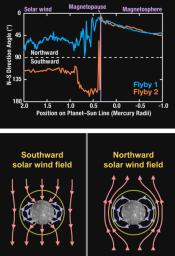
|
MESSENGER Explores Interactions between Mercury’s Magnetosphere and the Solar Wind
- Click the image above for a larger view
- Full-Res JPEG (615 x 900) (77.1 kB)
- Full-Res TIFF (615 x 900) (1.7 MB)
Caption:
The top figure shows the angle that the magnetic field made with the northward direction for the outbound passes through the magnetopause and bow shock for the mission's first (blue) and second (orange) Mercury flybys. Although the magnetic field strengths were comparable for the two flybys (see PIA11404 ), the direction of the field outside the magnetosphere, imposed by the solar wind, was opposite: northward for flyby 1 and southward for flyby 2. The two encounters therefore present us with a nearly ideal "controlled" experiment to contrast Mercury's magnetosphere under these two opposite extremes in its interaction with the solar wind. The bottom figure illustrates the profound difference in magnetic connection between Mercury and the solar wind when the magnetic field in the solar wind is southward (left) as for flyby 2 versus northward (right) as for flyby 1. These views from the Sun show a notional cross section of the magnetic lines of force in the dawn-dusk meridian plane. For southward solar wind magnetic fields, the solar wind and planetary magnetic fields are connected over the poles and Mercury's magnetosphere is tightly coupled and strongly driven by the solar wind. By contrast, for northward solar wind magnetic fields, the magnetosphere is "closed" and there is minimal inter-connection between the solar wind and planetary magnetic fields.
Date Acquired:
January 14 and October 6, 2008
Instrument:
Magnetometer (MAG)
Background Info:
These images are from MESSENGER, a NASA Discovery mission to conduct the first orbital study of the innermost planet, Mercury. For information regarding the use of images, see the MESSENGER image use policy .
Cataloging Keywords:
| Name | Value | Additional Values |
|---|---|---|
| Target | Mercury | |
| System | ||
| Target Type | Planet | |
| Mission | MESSENGER | |
| Instrument Host | MESSENGER | |
| Host Type | Orbiter | |
| Instrument | Magnetometer | |
| Detector | ||
| Extra Keywords | Color, Magnetosphere | |
| Acquisition Date | ||
| Release Date | 2008-10-30 | |
| Date in Caption | 2008-10-06 | |
| Image Credit | NASA/Johns Hopkins University Applied Physics Laboratory/Carnegie Institution of Washington | |
| Source | photojournal.jpl.nasa.gov/catalog/PIA11408 | |
| Identifier | PIA11408 | |
